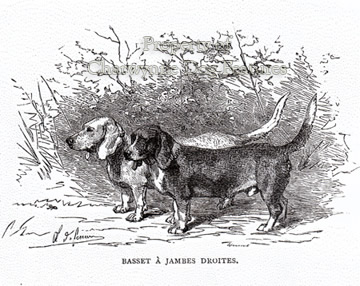978 BASSETS IN FRANCE
BASSETS IN FRANCE
by David Hancock


In his masterly La Venerie Francaise of 1858, Le Comte le Couteulx de Canteleu gave what might be described as the perfect summary of the Basset Hound in France: "Long body, short legs, large back, long leathers, lovely head, lovely voice, the Basset is full of good qualities. It always has a loathing for any beast, but rabbit and hare are particularly favoured quarry; however Bassets are a perfect pure breed for roe deer, wolf and boar. Usually white with black or fawn markings, often their hair is all black and thick with reddish touches under the eyes, over the chest and at the base of legs. Many are griffons and amongst these, many are white with large patches of coffee colour. The other varieties of Basset are primarily distinguished by very pronounced arching of the front legs, their colour is the same as that of the straight legged Bassets; only I know that the griffons are very rare. The Bassets are naturally very much slower than the other hounds.” He covers not just the hounds but the chosen quarry too. He was the most famous French hound breeder of his time and his admiration for the Basset is quite clear.


The breed we know best in Britain is outnumbered by those of France itself, such as the Artesien-Normand, the Bleu de Gascogne, the Fauve de Bretagne and the Griffon-Vendeen Petit and Grand. They are still used to hunt hare and rabbit for the gun, excelling in dense cover. But they are also used for flushing game birds, rather like spaniels. There have been theories that the type evolved as a 'sport' from the St Hubert Hound, in its various types, and was then committed to a hunt involving footed rather than mounted hunters. We know that the short leg in the Bloodhound is dominant genetically over the longer leg (Whitney, How to Breed Dogs, Orange Judd, 1947). The short leg is a Basset feature, whether crooked or straight. In the modern show ring, a straight-legged Basset would be laughed out of the ring, such is the conformist thinking there. For over a century too, their short legs have been considered an essential feature, with this lack of length becoming more exaggerated by the year.


A sporting writer, Pennell-Elmhurst, who wrote under the pseudonym Brooksby, is quoted in David Hindle’s The Hunting Basset of 2009, as writing, in 1896: “On Tuesday I had the opportunity of seeing a form of hunting altogether novel to me, viz., the chase of the hare by Basset Hounds, the Messrs Cooper having brought their pack from Delapre Abbey. I confess I was charmed. There was something so sporting in seeing these little hounds (to all appearance first cross between a turnspit and a foxhound) driving along in grass that almost hid them.” He likened their length of leg to the spit-turning dog as no other hound here displayed such a feature at that time. A wealthy London-based sportsman would not have been aware of the Welsh heelers with similar legs or the tendency for some working terriers to carry such a noticeable feature. The return to the straighter- and longer-legged hound as seen in the Hunting or English Basset Hound is to be welcomed.


In his most valuable book on hunting, published in the late 16th century, Jacques du Fouilloux makes an early reference to Bassets, describing them as badger dogs. He identified two types: those with a crooked front, which he stated were short-coated and went to ground better, and those with a straight front, which often carried the rough coat and ran game above ground as well as conducting terrier work. Du Fouilloux attributed the first home of these Bassets to the regions of Artois and Flandres. Both these regions have a record over five centuries of producing exceptional hounds. In his excellent book on The Basset Hound (Popular Dogs, 1968), George Johnston, who knew his hounds, produced a map of north-western Europe showing the distribution of the Basset type. This puts the rough-coated variety in north-west France (the Basset Fauve de Bretagne and the Basset Griffon-Vendeen), the smooth-coated variety in the north (the Bassets de Normandie, d'Artois and d'Ardennes) and the south (the Bassets de Saintonge and Bleu de Gascogne), with some smooth-coats on the German-French border in the Vosges and the Black Forest. He also mentions the allied breeds: the Dachshund in Germany, the Niederlaufhund of Switzerland and the Drever of Sweden.

The first French dog show, in Paris in 1863, issued a catalogue which listed Bassets as follows: straight-legged short and long-haired, crooked-legged short and long-haired, Baden Bassets, Burgos, St Domingo, Illyrian and Hungarian Bassets. This shows a Basset diaspora stretching from Brittany to Budapest and from the Black Forest to the Balkans. The Baden Basset would have been the Dachsbracke or badger hound. The Danes had a Dachsbracke too, known there as the Strellufstover, and now embraced by the Drever of northern Scandinavia. These short-legged but usually straight-legged hounds were used to drive game to the waiting guns. It is surprising that, whilst the Swiss have developed several breeds of Niederlaufhunde, the French border areas with Switzerland have none. The wide influence of the game little Basset Hound breeds of France, both straight and longer-legged, is not hard to see.